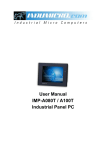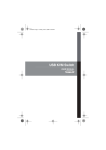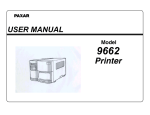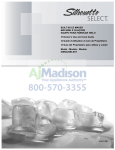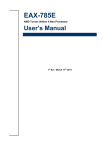Download EnGenius EUB12OOAC User manual
Transcript
User Manual EUB12OOAC version 1.0 Dual Band Wireless ACI200 USB Adapter USB 3.0 and Wireless AC for intense media streaming IMPORTANT To install this USB Adapter, please refer to the Quick Start Guide included in the product packaging. 2 Table of Contents Chapter 4 MAC OS X ........................................................... 25 Installing the Driver ................................................................... 26 Uninstalling the Driver ............................................................ 29 Wireless LAN Utility ................................................................... 30 Profile ................................................................................................. 30 Wireless Network Properties Dialog ................................ 31 Adding a Profile ............................................................................ 32 Editing a Profile ........................................................................... 34 Available Network ........................................................................ 35 Advanced Settings ........................................................................ 36 Wi-Fi Protected Setup / PIN Input Config ......................... 37 Push Button Config / Information ........................................ 38 Chapter 1 Product Overview ................................................. 4 Key Features / System Requirements .................................... 5 Applications / Network Configuration ...................................... 6 Technical Specifications / Physical Interface ..................... 7 Chapter 2 WPS Setup .............................................................. 8 WPS Setup ........................................................................................... 9 Chapter 3 Windows ............................................................... 10 Installing the Driver ................................................................... 11 Uninstalling the Driver ............................................................. 12 Wireless LAN Utility ..................................................................... 13 Profile ................................................................................................. 14 Wireless Network Properties Dialog .................................... 15 Adding a Profile ............................................................................. 16 Editing a Profile ........................................................................... 18 Available Network ...................................................................... 20 Status ................................................................................................ 21 Wi-Fi Protected Setup / PIN Input Config ............................ 22 Push Button Config ................................................................... 24 Appendix .................................................................................. 39 FCC Interference Statement ...................................................... 40 Industry Canada Statement .................................................... 41 Europe – EU Declaration of Conformity ............................. 43 3 Chapter 1 Product Overview 4 Product Overview Key Features • Up to 300 or 867 Mbps Wireless Speed • Draft IEEE 802.11AC Compliant • Backward compatible with IEEE 802.11a/b/g/n • Dual-Frequency Band (2.4GHz/5GHz) • High Speed USB 3.0 Interface • WPS Button for Wireless Easy Setup • Support WEP/WPA and WPA2 Security Encryption Introduction The EnGenius EUB1200AC is a Wireless AC USB 3.0 Adapter for use with desktop or laptop comuters running Window 7, Window 8 or Mac OS X (10.8) operating systems. It should not be used with tablets, Blu-ray players, HDTVs or other USB-enabled devices. It delivers the next generation of 802.11ac wireless technology and makes your wireless connectivity faster and wider to meet the growing demand for streaming high-bandwidth video and other multimedia applications. speed and dual band technology, the EUB1200AC can avoid Wi-Fi signal interference and ensure top Wi-Fi speeds and reliable connections. The incredible speed of the EUB1200AC USB adapter makes heavy traffic networking activities more flexible and takes the wireless into practical road. It supports the 2T2R MIMO architecture with fully forward compatibility with IEEE802.11n. With up to 300 or 867 Mbps • Windows 7 / Windows 8 or MAC OS X (10.8) operating system. System Requirements The following are the minimum system requirements in order to use the USB adapter. • 5 0 MB of free disk space for installing the USB adapter driver and utility program. Maximum data rates are based on draft IEEE 802.11ac and IEEE 802.11 standards. Actual throughput and range may vary depending on many factors including environmental conditions, distance between devices, radio interference in the operating environment, and mix of devices in the network. EnGenius Technologies, Inc. EnShare™ supports both FAT32 and NTFS USB formats. Transfer speeds of data from your router-attached USB storage device to a remote/ mobile device may vary based on Internet uplink and downlink speeds, bandwidth traffic at either send or receive locations, the data retrieval performance of the attached storage device or other factors. EnGenius does not guarantee compatibility with all USB drives. EnGenius does not warrant its products or EnShare from loss of data or loss of productivity time. Features and specifications subject to change without notice. Trademarks and registered trademarks are the property of their respective owners. For United States of America: Copyright ©2013 EnGenius Technologies, Inc. All rights reserved. 5 Product Overview Applications Ad-hoc (peer-to-peer) Mode EnGenius wireless LAN products are easy to install and easy to use. The following list describes some of the many applications made possible through the EnGenius wireless LAN products: This is the simplest network configuration with several computers equipped with the PC Cards that form a wireless network whenever they are within range of one another. In ad-hoc mode, each client is peer-to-peer, would only have access to the resources of the other client and does not require an access point. This is the easiest and least expensive way for the SOHO to set up a wireless network. The image below depicts a network in ad-hoc mode. • Difficult-to-wire environments • Temporary workgroups • Accessing real-time information • Frequently changing environments • Small Office and Home Office (SOHO) networks Infrastructure Mode • Wireless extensions to Ethernet networks The infrastructure mode requires the use of an Access Point (AP). In this mode, all wireless communication between two computers has to be via the AP. It doesn’t matter if the AP is stand-alone or wired to an Ethernet network. If used in standalone, the AP can extend the range of independent wireless LANs by acting as a repeater, which effectively doubles the distance between wireless stations. • Wired LAN backup • Training and Educational facilities Network Configuration To better understand how the wireless LAN products work together to create a wireless network, it might be helpful to depict some of the possible wireless LAN PC card network configurations. EnGenius wireless LAN products can be configured as: • Ad-hoc (or peer-to-peer) for departmental or SOHO LANs. • Infrastructure for enterprise LANs. 6 Technical Specifications Physical Interface Certifications: FCC Part 15, ETSI 300/328/CE Dimensions and Weights Weight: 0.32Ibs. Width: 5.5” Length: 5.3” Height: 1.37” Software Features Wireless WEP, WPA/WPA2 (AES/TKIP), WPS, WMM Drivers Windows 7/ Vista / XP / 2000 Apple Mac OS 10.7 (Lion supportive) and the older version Physical/Environment Conditions Operating: Temperature: 0°C to 45°C (32°F to 113°F) Humidity (non-condensing): 15% – 95% typical Storage: Temperature: -10°C to 75°C (14°F to 167°F) Humidity (non-condensing): 15% – 95% typical 1 3 2 1 LED Indicator 2 WPS Button — Wi-Fi Protected Setup button. To associate another WPS-enabled client device (computer, wireless media bridge, USB adapter, etc.) press the WPS button for 2 to 5 seconds on the router while also pressing the WPS button on the end device. 3 USB Connector 7 Chapter 2 WPS Setup 8 WPS Setup 1. Press and hold down the WPS button on your router (check with the User Manual that came with your router for any further instructions if necessary). 2. Within 2 minutes, press and hold down the WPS button on the EUB1200AC for 2 seconds. The LED should start to blink. 3. Wait for 2 minutes. 4. Confirm that the connection was successful by opening a web browser or checking the wireless signal indicator icon. 9 Chapter 3 Windows 10 Installing and Uninstalling the Driver Installing the Driver 2. Click on Windows Driver to start the install process. Before you can use the EUB1200AC Dual Band USB Adapter you must install the device driver. To install the USB adapter drivers, follow these steps: 1. Insert the CD-ROM that was provided to you in this package. The setup should run automatically. If the setup does not run automatically, then the setup.exe file must be selected manually from the CD-ROM drive. 3. Click on the Next button to begin the driver installation. 11 Uninstalling the Driver 4. Wait until the driver and client utility is installed. If you want to remove the EUB1200AC EUB1200AC Dual Band USB Adapter from your system, use device’s uninstall application or the Windows uninstall process. 5. When installation is complete click on the Finish button to restart your computer. 12 Wireless LAN Utility General There are five sections that allow the user to configure and monitor the device: general, profile, available networks, status, and Wi-Fi protected setup. The General section shows the connection status, speed, type, encryption, SSID, signal strength, and link quality of the AC1200 Dual Band USB Adapter. Additional configuration options located at the bottom of the window that define the behavior of the utility. The available options are as follows: Show Tray Icon: Show/hide the Utility icon in the system tray. Radio Off: Temporarily turn off wireless radio. Disable Adapter: Temporarily disable the wireless adapter Click on the Renew IP button to re-initiate the wireless connection with the AP. 13 Profile The Profile section is used to create and modify profiles that the AC1200 Dual Band USB Adapter uses to connect to access points. To create or modify an access point profile, use the following buttons: Add: Manually enter an access point’s configuration settings. Edit: Modify an access point’s configuration settings. Remove: Delete the configuration settings of an access point. Duplicate: Clone an access point’s profile. Set Default: Reset all saved settings. 14 Wireless Network Properties Dialog Ad hoc: Enables the adapter to operate in ad hoc or infrastructure mode. Use the wireless network properties dialog to enter the connection properties for an access point. Profile Name: The name of the access point that is shown in the profile list. Fill in the following wireless network properties to create an access point profile: Network Name (SSID): The name of the access point as shown on the network. Channel: The channel that the access point is broadcasting on. Network Authentication: The protocol used for network authentication. Data Encryption: The protocol used for data encryption. ASCII: Enables use of ASCII characters in the passphrase. Passphrase: Enables the use of hexadecimal characters passphrase. Key Index (advanced): User has to specify which of the four keys will be active. Please make sure that both the AP/Router you are connected to and the EUB1200AC use the same key. Network Key: The encryption key used to encrypt the data packets during data transmission. 15 Adding a Profile Note: When using the ASCII or PASSPHRASE feature the password must be obtained from the router. 3. Enter the profile name in Profile Name. 4. Enter the SSID in the Network Name (SSID). To add a profile, follow these steps: Note: The list of channels is only available if the ad hoc checkbox is selected. 1. Click the Add button. 2. Select the checkbox to specify an ad hoc network. 5. Select a channel from the Channel list. Available channels are from 1 to 161. Note: If the ad hoc checkbox is selected, Profile Name is not available. 6. Select a network authentication protocol from the Network Authentication protocol list. The following protocols can be selected: • Open System • Shared Key • WPA-PSK • WPA2-PSK • WPA 802.1X • WPA2 802.1X • WEP 802.1X 16 7. Select the ASCII checkbox to enter a password using ASCII characters. 9. Select the key index from the Key index list. 10.Enter the network key value in Network key. 11.Enter the same network key value again in Confirm network key. 12.Click the OK button to save the profile settings or the Cancel button to discard settings. 8.Select the PASSPHRASE checkbox to enter a password using hexadecimal characters. The passphrase key length can be either 64 or 128 bits. 17 Editing a Profile Note: When using the ASCII or PASSPHRASE feature the password must be obtained from the router. 3. Enter the profile name in Profile Name. 4. Enter the SSID in the Network Name (SSID). To edit a profile, follow these steps: Note: The list of channels is only available if the ad hoc checkbox is selected. 1. Click the Edit button. 2. Select the checkbox to specify an ad hoc network. 5. Select a channel from the Channel list. Available channels are from 1 to 161. Note: If the ad hoc checkbox is selected, Profile Name is not available. 6. Select a network authentication protocol from the Network Authentication protocol list. The following protocols can be selected: • Open System • Shared Key • WPA-PSK • WPA2-PSK • WPA 802.1X • WPA2 802.1X • WEP 802.1X 18 7. Select the ASCII checkbox to enter a password using ASCII characters. 9. Select the key index from the Key index list. 10.Enter the network key value in Network key. 11.Enter the same network key value again in Confirm network key. 12.Click the OK button to save the profile settings or the Cancel button to discard settings. 8.Select the PASSPHRASE checkbox to enter a password using hexadecimal characters. The passphrase key length can be either 64 or 128 bits. 19 Available Network You can find access points that are within the proximity of your adapter by using the device to scan for them. The information returned by the adapter is shown in a list and includes the SSID, channel, encryption type, authentication type and signal strength If you want to view available access points, click the Refresh button. If you want to add an access point to your list of profiles, click on the Add to Profile button. 20 Status The Status section shows a more detailed view of the information about the status of the adapter and the network connection. The following information is displayed in the section: • Manufacturer • NDIS Driver Version • Short Radio Header • Encryption type • Authenticate type • Channel Set • MAC Address • Data Rate • Channel used • Status • SSID • Network Type • Power Save Mode • Associated AP MAC • Up Time (hh:mm:ss) 21 Wi-Fi Protected Setup PIN Input Config Note: You must enter the PIN code in your router’s configuration dialog before establishing a connection. Use the Wi-Fi Protected Setup function to setup a connection between the adapter and a WPS enabled router. There are two ways to create a WPS connection: pin input config (PIN) or push button config (PBC). 1. Click on the PIN Input Config button to start the PIN code process. 22 2. Select Yes to start scanning for access points The following dialog is shown while the router is accepting the connection. 3. Select the target AP and click the Select button. When the dialog disappears the connection is established. 23 Push Button Config 1. Click on the Push Button Config button to start the process. 2. Click on the Push Button Config in the following dialog. 3. Press the WPS button on the access point. The connection is established within a few seconds. Note: The Push Button Config button and the WPS button on the access point must be pushed within ten seconds of each other. 24 Chapter 4 MAC OS X 25 Installing and Uninstalling the Driver Installing the Driver 3. Select the zip file for the correct driver of Mac OS X of your computer. (The Mac OS X version of the computer can be found by clicking on the Apple logo at the top left of the screen and selecting About This Mac.) Double click on the zip file to extract the driver installation program to the Downloads folder. Before you can use the EUB1200AC Dual Band USB Adapter you must install the device driver. To install the USB adapter drivers, follow these steps: 1. Insert the CD-Rom. An icon labeled EUB1200AC should appear on the desktop. 2. Click on the icon. Then click on the Drivers folder. 26 4. Click on the newly extracted WLAN_11ac_USB_ MacOS10…folder. 6. Click on the Continue button to configure the next step. 5. Click on the Installer.pkg icon to run the program. 7. Read the Important Information and then click on the Install button. 27 8. Select a language to read the software license agreement and then click on the Continue button to display the license dialog. 10. Click on the Install button to begin the installation process or Go Back to return to the previous step. 9.Click on the Read License button to read the license agreement. After you have read the agreement click on the Agree button to continue or Disagree to cancel the installation. 11.When the installation warning dialog is shown click the Continue Installation button to continue or the Cancel button to abort the process. 28 Uninstalling the Driver 12.Click the Restart button to restart your system Note: The adapter may not function properly if you do not restart the system. If you want to remove the AC1200 Dual Band USB Adapter from your system, follow these steps: 1. Go to the Applications folder and drag the Wireless-AC Network Utility to the Trash 2. Click on the uninstall.command icon found in the Wlan_11ac_USB_MacOS… folder containing the installer. 13.Insert the USB adapter into the USB port. MAC OS X will detect and install the new hardware. 14.The client utility is installed in the Applications folder. 29 Wireless LAN Utility Profile There are six sections that allow the user to configure and monitor the device: link status, profiles, available network, advanced setting, WPS and information. The Profile section is used to create and modify profiles that the AC1200 Dual Band USB Adapter uses to connect to access points. Link Status The Link Status section shows the MAC address, SSID, BSSID, security type, connection status, network type, channel, link speed, and signal strength of the AC1200 Dual Band USB Adapter. To create or modify an access point profile, use the following buttons: Add: Manually enter an access point’s configuration settings. Edit: Modify an access point’s configuration settings. Remove: Delete the configuration settings of an access point. Duplicate: Clone an access point’s profile. Set Default: Reset all saved settings. Click on the Turn Radio OFF button to deactivate the adapter. Click on the Turn Radio ON button to activate the adapter. 30 Wireless Network Properties Dialog Fill in the following wireless network properties to create an access point profile: Use the wireless network properties dialog to enter the connection properties for an access point. Profile Name: The name of the access point that is shown in the profile list. SSID: The name of the access point as shown on the network. Ad hoc: Enables the adapter to operate in ad hoc or infrastructure mode. Channel: The channel that the access point is broadcasting on. Network Authentication: The protocol used for network authentication. Data Encryption: The protocol used for data encryption. ASCII: Enables use of ASCII characters in the passphrase. Key Index (advanced): User has to specify which of the four keys will be active. Please make sure that both the AP/Router you are connected to and the EUB1200AC use the same key. Network Key: The encryption key used to encrypt the data packets during data transmission. 31 Adding a Profile Note: When using the ASCII or PASSPHRASE feature the password must be obtained from the router. 3. Enter the profile name in Profile Name. 4. Enter the SSID in SSID. To add a profile, follow these steps: Note: The list of channels is only available if the ad hoc checkbox is selected. 1. Click the Add button. 2. Select the checkbox to specify an ad hoc network. 5. Select a channel from the Channel list. Available channels are from 1 to 11. Note: If the ad hoc checkbox is selected, Profile Name is not available. 6. Select a network authentication protocol from the Network Authentication protocol list. The following protocols can be selected: • Open System • Shared Key • WPA-PSK • WPA2-PSK • WPA 802.1X • WPA2 802.1X • WEP 802.1X 32 7. Select the ASCII checkbox to enter a five or thirteen character password using the WEP protocol. 8. Enter the network key value in Network key. For 64-bit key length enter 10 hexadecimal characters. For 128-bit key length enter 26 hexadecimal characters. .9. Enter the same network key value again in Confirm network key. 10.Select the key index from the Key index list. 11.Click the OK button to save the profile settings or the Cancel button to discard settings. 33 Editing a Profile 3. Enter the profile name in Profile Name. Note: When using the ASCII or Network key feature the password must be obtained from the router. 4. Enter the SSID in the SSID. Note: The list of channels is only available if the ad hoc checkbox is selected. To edit a profile, follow these steps: 1. Click the Add button. 5. Select a channel from the Channel list. Available channels are from 1 to 11. 2. Select the checkbox to specify an ad hoc network. 6. Select a network authentication protocol from the Network Authentication protocol list. The following protocols can be selected: Note: If the ad hoc checkbox is selected, Profile Name is not available. • Open System • Shared Key • WPA-PSK • WPA2-PSK • WPA 802.1X • WPA2 802.1X • WEP 802.1X 34 Available Network 7. Select the ASCII checkbox to enter a five or thirteen character password using the WEP protocol. You can find access points that are within the proximity of your adapter by using the device to scan for them. The information returned by the adapter is shown in a list and includes the SSID, channel, authentication type, encryption type and BSSID (MAC address). 8. Enter the network key value in Network key. For 64-bit key length enter 10 hexadecimal characters. For 128-bit key length enter 26 hexadecimal characters. 9. Enter the same network key value again in Confirm network key. 10.Select the key index from the Key index list. Click the Refresh button to view available access points. 11.Click the OK button to save the profile settings or the Cancel button to discard settings. Click the Connect button to connect to an access point without setting up a profile. Click on the Add to Profile button to add an access point to your list of profiles. 35 Advanced Settings 3. Set the PSP gaming mode from the PSP Xlink Mode list. In the Advanced Settings section you can modify the 802.11b preamble mode, QoS mode, and PSP Xlink mode. The options are Enabled or Disabled. 4. Set the Fragment Threshold by moving the slider control or manually entering a value in the text box. The fragment threshold specifies the maximum size of a packet during data transmission. A value too low could lead to low performance. 5. Set the RTS Threshold by moving the slider control or manually entering a value in the text box. If the packet size is smaller than the RTS threshold, the device will not use RTS/CTS to send the data packet. 6. Click the Refresh button to refresh the settings. Click the Apply button to save changes settings. Click Set Default button to change the current settings back to their default values. 1. Set the preamble mode setting from the 802.11b PreambleMode list. Choose Auto to let the device make the selection, Long for better device compatibility, and Short for better network efficiency. 2. Set the QOS mode from the QOS Mode list. The options are Enabled or Disabled. 36 Wi-Fi Protected Setup PIN Input Config Note: You must enter the PIN code in your router’s configuration dialog before establishing a connection. If you do not want to set up a protected connection manually, you can use the Wi-Fi protected setup function. There are two ways to create a WPS connection: pin input config (PIN) or push button config (PBC). Before selecting either method, click the SCAN button to locate the access points within the proximity of the adapter. 1. Select the target access point 2. Click the PIN button. When the connection is established the Link Status section will show the connection information. See Link Status for 37 Push Button Config Information 1. Select the target access point. The Information tab displays information about the network driver version and date. 2. Click the PBC button Note: The PBC button and the WPS button on the access point must be pushed within ten seconds of each other. 3. Press the WPS button on the access point. When the connection is established the Link Status section will show the connection information. See Link Status for more details. 38 Appendix 39 Appendix A Federal Communication Commission Interference Statement This device complies with Part 15 of the FCC Rules. Operation is subject to the following two conditions: (1) This device may not cause harmful interference, and (2) this device must accept any interference received, including interference that may cause undesired operation. This equipment has been tested and found to comply with the limits for a Class B digital device, pursuant to Part 15 of the FCC Rules. These limits are designed to provide reasonable protection against harmful interference in a residential installation. This equipment generates, uses and can radiate radio frequency energy and, if not installed and used in accordance with the instructions, may cause harmful interference to radio communications. However, there is no guarantee that interference will not occur in a particular installation. If this equipment does cause harmful interference to radio or television reception, which can be determined by turning the equipment off and on, the user is encouraged to try to correct the interference by one of the following measures: • Reorient or relocate the receiving antenna. • Increase the separation between the equipment and receiver. • Connect the equipment into an outlet on a circuit different from that to which the receiver is connected. • Consult the dealer or an experienced radio/TV technician for help WARNING! Any changes or modifications not expressly approved by the party responsible for compliance could void the user’s authority to operate this equipment. This transmitter must not be co-located or operating in conjunction with any other antenna or transmitter. Operations in the 5.15-5.25GHz band are restricted to indoor usage only Radiation Exposure Statement The product comply with the FCC portable RF exposure limit set forth for an uncontrolled environment and are safe for intended operation as described in this manual. The further RF exposure reduction can be achieved if the product can be kept as far as possible from the user body or set the device to lower output power if such function is available. The USB dongle transmitter is approved for use in typical laptop computers.To comply with FCC RF exposure requirements, it should not be used in other devices or certain laptop and tablet computer configurations where the USB connectors on the host computer are unable to provide or ensure the necessary operating configurations intended for the device and its users or bystanders to satisfy RF exposure compliance requirements 40 Appendix B Industry Canada Statement This device complies with RSS-210 of the Industry Canada Rules. Operation is subject to the following two conditions: (1) This device may not cause harmful interference, and (2) this device must accept any interference received, including interference that may cause undesired operation. Ce dispositif est conforme à la norme CNR-210 d’Industrie Canada applicable aux appareils radio exempts de licence. Son fonctionnement est sujet aux deux conditions suivantes: (1) le dispositif ne doit pas produire de brouillage préjudiciable, et (2) ce dispositif doit accepter tout brouillage reçu, y compris un brouillage susceptible de provoquer un fonctionnement indésirable. WARNING! (i) the device for operation in the band 5150-5250 MHz is only for indoor use to reduce the potential for harmful interference to cochannel mobile satellite systems; (ii) high-power radars are allocated as primary users (i.e. priority users) of the bands 5250-5350 MHz and 5650-5850 MHz and that these radars could cause interference and/or damage to LE-LAN devices. WARNING! (i) Les dispositifs fonctionnant dans la bande 5 150-5 250 MHz sont réservés uniquement pour une utilisation à l’intérieur afin de réduire les risques de brouillage préjudiciable aux systèmes de satellites mobiles utilisant les mêmes canaux; (ii) De plus, les utilisateurs devraient aussi être avisés que les utilisateurs de radars de haute puissance sont désignés utilisateurs principaux (c.- à-d., qu’ils ont la priorité) pour les bandes 5 250-5 350 MHz et 5 650-5 850 MHz et que ces radars pourraient causer du brouillage et/ou des dommages aux dispositifs LAN-EL. 41 Radiation Exposure Statement The product comply with the Canada portable RF exposure limit set forth for an uncontrolled environment and are safe for intended operation as described in this manual. The further RF exposure reduction can be achieved if the product can be kept as far as possible from the user body or set the device to lower output power if such function is available. Déclaration d’exposition aux radiations: Le produit est conforme aux limites d’exposition pour les appareils portables RF pour les États-Unis et le Canada établies pour un environnement non contrôlé. Le produit est sûr pour un fonctionnement tel que décrit dans ce manuel. La réduction aux expositions RF peut être augmentée si l’appareil peut être conservé aussi loin que possible du corps de l’utilisateur ou que le dispositif est réglé sur la puissance de sortie la plus faible si une telle fonction est disponible. 42 Appendix C Europe – EU Declaration of Conformity This device complies with the essential requirements of the R&TTE Directive 1999/5/EC. The following test methods have been applied in order to prove presumption of conformity with the essential requirements of the R&TTE Directive 1999/5/EC: • EN60950-1 Safety of Information Technology Equipment • EN 62479: Assessment of electronic and electrical equipment related to human exposure restrictions for electromagnetic fields (0 Hz-300 GHz) • EN 300 328 Electromagnetic compatibility and Radio spectrum Matters (ERM); Wideband Transmission systems; Data transmission equipment operating in the 2,4 GHz ISM band and using spread spectrum modulation techniques; Harmonized EN covering essential requirements under article 3.2 of the R&TTE Directive • EN 301 893 Broadband Radio Access Networks (BRAN); 5 GHz high performance RLAN; Harmonized EN covering essential requirements of article 3.2 of the R&TTE Directive • EN 301 489-1 Electromagnetic compatibility and Radio Spectrum Matters (ERM); ElectroMagnetic Compatibility (EMC) standard for radio equipment and services; Part 1: Common technical requirements • EN 301 489-17 Electromagnetic compatibility and Radio spectrum Matters (ERM); ElectroMagnetic Compatibility (EMC) standard for radio equipment and services; Part 17: Specific conditions for 2,4 GHz wideband transmission systems and 5 GHz high performance RLAN equipment 43 This device is a 5GHz wideband transmission system (transceiver), intended for use in all EU member states and EFTA countries, except in France and Italy where restrictive use applies. In Italy the end-user should apply for a license at the national spectrum authorities in order to obtain authorization to use the device for setting up outdoor radio links and/or for supplying public access to telecommunications and/or network services. This device may not be used for setting up outdoor radio links in France and in some areas the RF output power may be limited to 10 mW EIRP in the frequency range of 2454 – 2483.5 MHz. For detailed information the end-user should contact the national spectrum authority in France. Česky [Czech] [Jméno výrobce] tímto prohlašuje, že tento [typ zařízení] je ve shodě se základními požadavky a dalšími příslušnými ustanoveními směrnice 1999/5/ES. Dansk [Danish] Undertegnede [fabrikantens navn] erklærer herved, at følgende udstyr [udstyrets typebetegnelse] overholder de væsentlige krav og øvrige relevante krav i direktiv 1999/5/EF. Deutsch [German] Hiermit erklärt [Name des Herstellers], dass sich das Gerät [Gerätetyp] in Übereinstimmung mit den grundlegenden Anforderungen und den übrigen einschlägigen Bestimmungen der Richtlinie 1999/5/EG befindet. Eesti [Estonian] Käesolevaga kinnitab [tootja nimi = name of manufacturer] seadme [seadme tüüp = type of equipment] vastavust direktiivi 1999/5/EÜ põhinõuetele ja nimetatud direktiivist tulenevatele teistele asjakohastele sätetele. English Hereby, [name of manufacturer], declares that this [type of equipment] is in compliance with the essential requirements and other relevant provisions of Directive 1999/5/EC. Español [Spanish] Por medio de la presente [nombre del fabricante] declara que el [clase de equipo] cumple con los requisitos esenciales y cualesquiera otras disposiciones aplicables o exigibles de la Directiva 1999/5/CE. Ελληνική [Greek] ΜΕ ΤΗΝ ΠΑΡΟΥΣΑ [name of manufacturer] ΔΗΛΩΝΕΙ ΟΤΙ [type of equipment] ΣΥΜΜΟΡΦΩΝΕΤΑΙ ΠΡΟΣ ΤΙΣ ΟΥΣΙΩΔΕΙΣ ΑΠΑΙΤΗΣΕΙΣ ΚΑΙ ΤΙΣ ΛΟΙΠΕΣ ΣΧΕΤΙΚΕΣ ΔΙΑΤΑΞΕΙΣ ΤΗΣ ΟΔΗΓΙΑΣ 1999/5/ΕΚ. 44 Français [French] Par la présente [nom du fabricant] déclare que l’appareil [type d’appareil] est conforme aux exigences essentielles et aux autres dispositions pertinentes de la directive 1999/5/CE. Italiano [Italian] Con la presente [nome del costruttore] dichiara che questo [tipo di apparecchio] è conforme ai requisiti essenziali ed alle altre disposizioni pertinenti stabilite dalla direttiva 1999/5/CE. Latviski [Latvian] Ar šo [name of manufacturer / izgatavotāja nosaukums] deklarē, ka [type of equipment / iekārtas tips] atbilst Direktīvas 1999/ 5/EK būtiskajām prasībām un citiem ar to saistītajiem noteikumiem. Lietuvių [Lithuanian] Šiuo [manufacturer name] deklaruoja, kad šis [equipment type] atitinka esminius reikalavimus ir kitas 1999/5/EB Direktyvos nuostatas. Nederlands [Dutch] Hierbij verklaart [naam van de fabrikant] dat het toestel [type van toestel] in overeenstemming is met de essentiële eisen en de andere relevante bepalingen van richtlijn 1999/5/EG. Malti [Maltese] Hawnhekk, [isem tal-manifattur], jiddikjara li dan [il-mudel tal-prodott] jikkonforma mal-ħtiġijiet essenzjali u ma provvedimenti oħrajn relevanti li hemm fid-Dirrettiva 1999/5/EC. Magyar [Hungarian] Alulírott, [gyártó neve] nyilatkozom, hogy a [... típus] megfelel a vonatkozó alapvetõ követelményeknek és az 1999/5/EC irányelv egyéb elõírásainak. Polski [Polish] Niniejszym [nazwa producenta] oświadcza, że [nazwa wyrobu] jest zgodny z zasadniczymi wymogami oraz pozostałymi stosownymi postanowieniami Dyrektywy 1999/5/EC. Português [Portuguese] [Nome do fabricante] declara que este [tipo de equipamento] está conforme com os requisitos essenciais e outras disposições da Directiva 1999/5/CE. Slovensko [Slovenian] [Ime proizvajalca] izjavlja, da je ta [tip opreme] v skladu z bistvenimi zahtevami in ostalimi relevantnimi določili direktive 1999/5/ES. Slovensky [Slovak] [Meno výrobcu] týmto vyhlasuje, že [typ zariadenia] spĺňa základné požiadavky a všetky príslušné ustanovenia Smernice 1999/5/ES. Suomi [Finnish] [Valmistaja = manufacturer] vakuuttaa täten että [type of equipment = laitteen tyyppimerkintä] tyyppinen laite on direktiivin 1999/5/EY oleellisten vaatimusten ja sitä koskevien direktiivin muiden ehtojen mukainen. Svenska [Swedish] Härmed intygar [företag] att denna [utrustningstyp] står I överensstämmelse med de väsentliga egenskapskrav och övriga relevanta bestämmelser som framgår av direktiv 1999/5/EG. 45














































